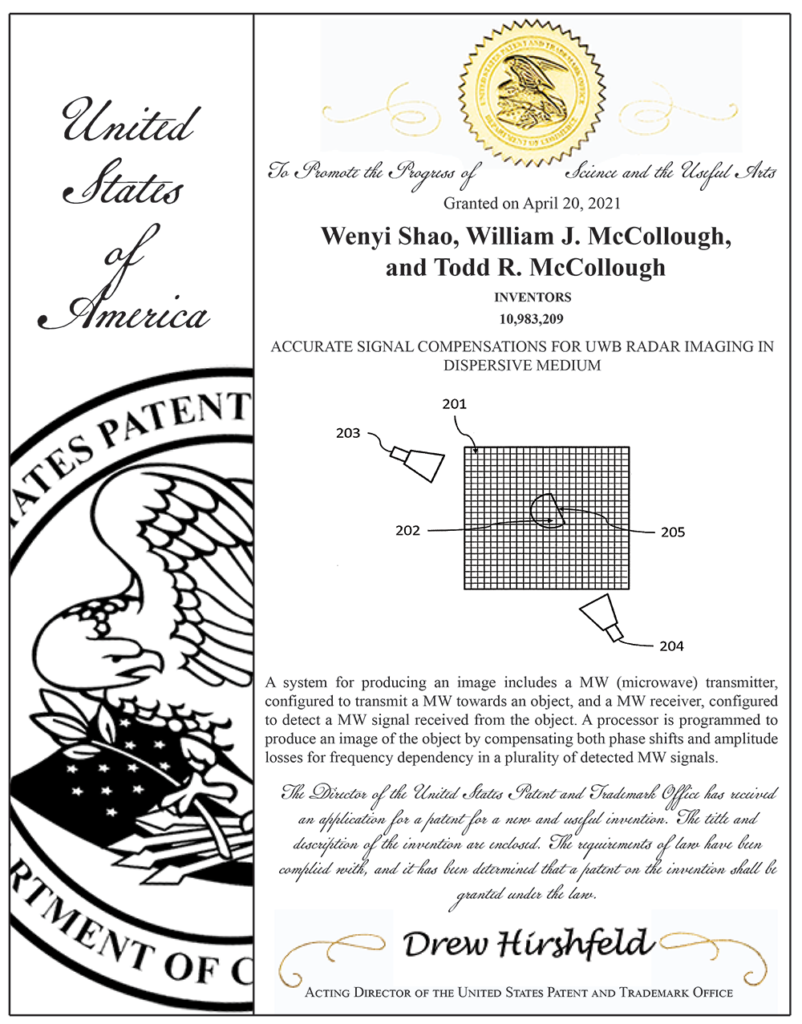During my work with the Celadon Research Division of Ellumen Inc., I was a co-inventor on a patent titled Accurate Signal Compensations for UWB Radar Imaging in Dispersive Medium” that issued on April 20, 2021. This is the six patent I have been a co-inventor on. If you are interested in learning more about my prior five patents see the post titled “Description of Three Patents Named Co-Inventor On Assigned to Ellumen Inc” and also the posts titled “Microwave Imaging Device Patent Named Co-Inventor on Assigned to Ellumen Inc” and “Phase Confocal Method for Near-Field Microwave Imaging Patent named co-inventor on Issued“.
The patent describes a method titled phase shift and sum (PSAS), which is a novel radar imaging approach which considers the dispersion and loss of the medium as a UWB wave propagates through. PSAS takes into account the propagation speed, path, and decay of each frequency component in a UWB pulse individually. The time-shift evaluation used in prior methods is replaced by a phase-shift evaluation between the sensor and the object at each frequency involved. This method is useful because materials are known to be dispersive. For example, in ground penetrating radar (GPR) and underground surveillance, soil, sands, etc. are dispersive and in biomedical electromagnetic imaging, human tissues are dispersive. When a medium is dispersive it leads to a multi-speed, multi-path, and multi-decay phenomenon in the UWB wireless signal, causing the time shift of the signal to be very difficult to be estimated, and thus poorer image quality is observed when conventional radar methods are used.
The patent provides protection for a system for producing an image comprising a microwave transmitter to transmit a microwave towards an object and a microwave receiver to detect a microwave signal from the object and where there is a processor programmed to produce an image by compensating for both phase shifts and amplitude losses for frequency dependency in the detected microwave signals and specifically where the processor sums the detected signals that have been compensated for both the phase shifts and amplitude losses. The patent also provides protection for a microwave imaging system that has a processor programmed to perform five specific tasks and a memory storing program for the processor and data that includes at least absorption data representation frequency dependence of microwave absorption. The five specific tasks the processor is programmed to include 1) determining a propagation distance from a transmitter to each pixel in a plurality of pixels, and then to a receiver, 2) determining a phase shift based on the propagation distance for each of the plurality of pixels for each of a plurality of discrete frequencies, 3) determining absorption based on the absorption data and propagation distance for each of the plurality of pixels for each of a plurality of discrete frequencies, 4) generating a pixel value for each of the plurality of pixels by combining measured scattered field values at the plurality of discrete frequencies, where the measure scattered field values have been compensated for frequency dependent phase shift, frequency dependent absorption, and refraction loss between at least two mediums, and 5) producing an microwave image that includes the plurality of pixel values.
Below is a patent certificate that was created to celebrate the accomplishment of having the patent granted. This is the second patent I have had issued since after the USPTO celebrated the issuance of 10 million patents and changed the patent cover design.

